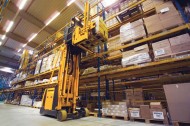 Critics of automated handling technology who had been clinging on to outdated theories about automation being inflexible and costly with a long pay-back period have, by and large, been won over and some degree of automation is increasingly specified for operations serving a diverse range of industries.
Critics of automated handling technology who had been clinging on to outdated theories about automation being inflexible and costly with a long pay-back period have, by and large, been won over and some degree of automation is increasingly specified for operations serving a diverse range of industries.
“Companies want to know how modern automated handling systems can help maximise supply chain efficiency,” says Steve Richmond, general manager of Jungheinrich UK Ltd’s systems and projects division.
The profile of the typical user of automation has evolved in line with developments in automated handling technology, as Steve Richmond explains: “Increasingly a more diverse range and size of business now recognise the advantages that modern automated handling technology can offer. While there are still some very large projects around, there is more significant growth in the number of small and medium sized automated projects.
“For instance, we are experiencing increased demand in the area of mini load cranes for handling cartons and totes etc. In the right application, high performance mini load systems can deliver products to picking and packing stations at tremendous speeds, outperforming many conventional, alternative systems. The increase in demand for the mini load product is one I expect to see increase significantly in the next few years.”
According to Steve Richmond, the current interest in automation is also being driven by a shift in the size and scope of modern systems.
“Many users now employ partial automation – hybrid systems that are part-automated and part-manual,” he says.
“In the past some companies shied away from automation because they felt that a move to an automated system would mean that every aspect of the operation would have to be automated,” he continues. “This is simply not the case. Automation no longer means that every aspect of the warehouse or distribution centre has to be automated – just the parts of it that will benefit most from automation.
He continues: “For instance, in many applications a strong case can often be made for automating the ‘bulk pallet’ operation and then designing the ‘picking operation’ to be as flexible as possible. This is a model that we at Jungheinrich have developed over a number of years and it lends itself to the phased development of a facility, that can also take into account changes in customer demand and product profile.
 Indeed, this ability to phase the introduction of automation within a distribution centre or warehouse is highly attractive to many companies, Steve Richmond says. He explains: “Consider an operation where the initial volumes dictate a low level manual forward picking area, (using conventional equipment) supported by an automated bulk store. As volumes grow, the picking area can be developed by increasing the number of pick faces and levels and then utilising high level order picking equipment. Up to this point there has been no need for the customer to invest heavily in the order picking areas due to the employment of conventional equipment and techniques. However, should there be stepped changes in volumes or product profile, automated picking or sortation technology can be introduced.”
Indeed, this ability to phase the introduction of automation within a distribution centre or warehouse is highly attractive to many companies, Steve Richmond says. He explains: “Consider an operation where the initial volumes dictate a low level manual forward picking area, (using conventional equipment) supported by an automated bulk store. As volumes grow, the picking area can be developed by increasing the number of pick faces and levels and then utilising high level order picking equipment. Up to this point there has been no need for the customer to invest heavily in the order picking areas due to the employment of conventional equipment and techniques. However, should there be stepped changes in volumes or product profile, automated picking or sortation technology can be introduced.”
“In applications where automated handlling systems are phased in, payback can be calculated for the individual phases of the project to provide the most effective utilisation of capital for the organisation,” he adds.
Steve Richmond contends that it is becoming easier to ‘sell’ the automation concept because the knowledge of customers and end users is growing all the time.
“In recent years,” he says “the knowledge base of our customers and end users has increased significantly. This is apparent not only in terms of their understanding of the products and solutions that are available in the marketplace, but how these often complex systems interact with other parts of the supply chain. This is without doubt a significant factor in the growing trend towards automation.”
Going forward, Steve Richmond believes that more and more companies are likely to conclude that automating those parts of the warehousing operation that follow a predictable pattern makes a lot of sense.
“But,” he says, “there is no such thing as a one-size-fits-all automated handling system.”
He adds: “For any project to deliver best practice it is essential that the right equipment is specified and for this to happen all aspects of the process – including product profile and material flow – must be considered from the outset.
“Unfortunately, some systems have been designed around the limited range of equipment that the supplier is able to offer and so, instead of ending up with a facility that suits the goods stored and the pick and product flow rates required, users get something that has been planned primarily to accommodate the restricted collection of handling equipment that their supplier has in its range.
Steve Richmond concludes: ”When considering automation you must look at all aspects of your overall supply chain and the key word is ‘scaleability’. By partially automating aspects of their storage operation and then adding to it as future demands change, more and more companies are reaping the benefits of automation without being forced to make the leap in to full automation that was once considered the only way to move away from a manual operation.”
Jungheinrich UK Ltd
Tel: 01908 363100




Comments are closed.